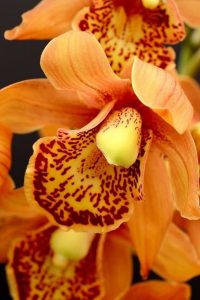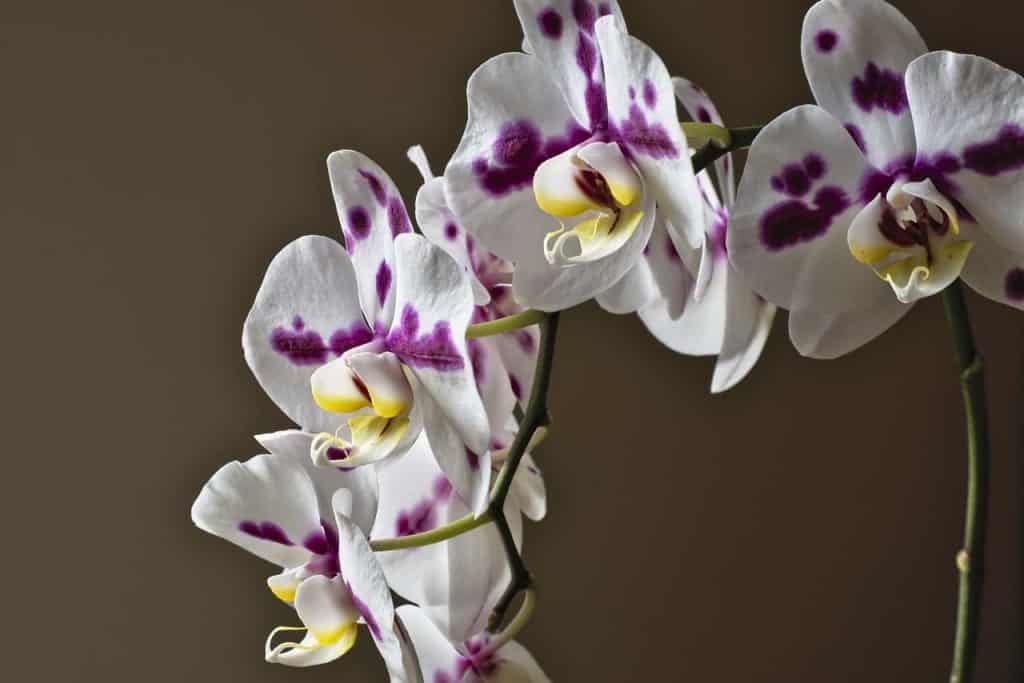Your orchid appears to be dying but you’re obviously not sure why that is (otherwise it wouldn’t appear to be dying).
In this article, we’ve put together a list of the most commonplace problems that people experience with indoor orchids. We’ve also provided you with the answers you need so you can fix the problem/s.
My orchid is not flowering.
What to do?
Solution 1: Your orchid probably wants more light.
Your orchid may not be flowering. This isn’t a sign that it’s dying. But what’s the point of having an orchid if it’s not going to flower?
There is no point because we have indoor orchids because we love the flowers.
How do you know that your orchid is not getting enough light, other than it’s not flowering?
The leaves might be a very dark green color. For the most part, indoor orchids need to be grown at or in a south-facing or east-facing window. A west-facing window can get too hot in the afternoon. A north-facing window is generally too dark.
While your orchid is in full bloom it’s fine to place it elsewhere in your home. Temporary repositioning to make the orchid more of a centerpiece will do no harm whatsoever.
Once the orchid is finished blooming, return it to its prior south- or east-facing window.
Solution 2: Daytime and nighttime temperatures can be varied.
Your orchid looks really healthy but it’s still refusing to bloom.
You can try this: Drop the nighttime temperature.
In the summertime, it’s good to place your orchids outside.
With a drop in temperature of 10-15 degrees F at nighttime, it can induce your orchid to start flowering.
Summering your orchids outdoors will do wonders for them! Oftentimes, a 10-15F, or more, drop in temperature at night will be enough to cause your orchid to bloom for you.
You can place your orchid or orchids outdoors during early spring and early fall. But if night temperatures fall below 55 degrees F you should bring them back indoors.
If there’s no place for your orchids outside you can position them very close to a window. Don’t allow the leaves to touch the glass. Just position the orchid close enough that it experiences a change in temperature between day and night. That in and of itself can be enough to induce flowering.

The flowers are falling off my orchid.
What to do?
Solution 1: Just because the flowers are dropping does not mean your orchid is dying.
If your orchid is store-bought, you’ll have no idea how long it’s been flowering. So if it’s relatively new to your home it doesn’t necessarily mean the flowers are relatively new on the plant.
Dropping flowers are perfectly natural for an orchid as they are for all plants. It’s merely part of the natural cycle.
When purchasing orchids, you might want to buy those that have buds that are still unopened at the spike (stem) tip. This will allow you to enjoy a longer flower display when you take your new orchid home.
Solution 2: Dropping orchid flowers may be a sign that the orchid is exposed to temperature extremes.
Bud blasting (when unopened flowers fail to open and drop off) occurs when the orchid is subjected to a sudden alteration in temperature.
That can occur when you’ve just purchased a new orchid and it’s cold outside. You take the orchid to your car and from your car, you take the orchid into your home.
What can you do to stop the sudden chill from occurring?
If you reside in a cooler climate, not a lot you can do. It’s perfectly normal. Again, though, doesn’t mean your orchid will die. It can, and will reflower, given some care and a little bit of attention.
Bud blasting isn’t only caused by a sudden drop in temperature. It’s also caused by a sudden change in the watering regime or in light.
Your orchid needs some time to adjust. After that, bud blast shouldn’t then be a problem.
The same applies if you bring your orchid into your home from your greenhouse. The orchid will likely experience some shock.
And, finally, a further cause of bud blast is when you position your orchid near a source of hot, dry air. Bud blast can occur if your orchid is subjected to that kind of scenario, particularly so if it’s already in bud.
The leaves on my orchid are becoming badly wrinkled.
What to do?
Solution: Likely if your orchid’s leaves have become wrinkled it’s down to overwatering or underwatering.
If you have a moth orchid (Phalaenopsis) which is the most common type of ‘in-the-home’ orchid (see the beautiful flower just below), just remember that unlike many other orchid species, moth orchids do not have pseudobulbs.
This means you shouldn’t allow your moth orchid to completely dry out. Or, if you do, it shouldn’t be allowed to remain completely dry for long.
Pseudobulbs are organs that store water and food. Cattleya orchids (another very popular orchid) have pseudobulbs. Again, though, Phalaenopsis do not.
So, a Phalaenopsis that becomes overly dry will demonstrate this through wrinkled leaves.
Try the potting medium. Place your finger into the potting medium and see if it’s completely dry. How about the roots. Are they looking wrinkled and dry?
If yes, your orchid badly needs water.
If your orchid is badly dehydrated, the entire pot should get a thorough soaking.
Place the pot in your sink or in a bucket of water. Or it can be positioned inside its decorative pot (the one with no holes in the base). Allow it to sit in water for a few hours.
Regular watering can be achieved in the same way. But don’t allow your orchid to sit in water for hours – that should only be done in an emergency.
For regular watering, allow your orchid to sit in water for 15-30 minutes. Then, allow the excess water to drain out.
Unless you’re treating your orchid after it’s been severely dehydrated, don’t ever allow it to sit in water for an extended period.
If your orchid has wrinkled leaves and you see that the roots are rotting, it’s more than likely caused by root rot. Obviously, in this case, you should not add water because the plant has had more than its fair share.
If your orchid does have root rot, if it’s bad, take the orchid out of the pot, remove the potting medium, and replace it with fresh medium.
After a few weeks, if there is a sign of life – new roots appearing and the leaves are no longer badly wrinkled, you’re in luck. If otherwise, you may as well invest in a new orchid.

My orchid is covered in white fluffy cotton stuff. What is it?
More than likely the white fluffy cotton stuff is mealybugs.
Don’t worry. While mealybugs do reproduce rapidly they’re not difficult to get rid of.
Another way to determine if your orchid has a mealybug infestation is that it will have sticky areas on the leaves. That’s the honeydew excretion. Same as aphids.
What to do?
Solution: Wipe the leaves with rubbing alcohol.
You can use rubbing alcohol to get rid of mealybugs, aphids, and scale.
To start out, remove anything you see – the mealybugs, that is – using your finger or with a paper towel or a small cloth.
70% concentration isopropyl alcohol is ideal. Dip a paper towel or a cotton ball into the isopropyl alcohol (rubbing alcohol). Then rub the leaves.
Don’t use another form of alcohol. And don’t use a concentration that is higher than 70%.
Keep going until the mealybugs are no longer.
The leaves of my orchid are turning yellow. Is the orchid dying?
What to do?
Solution 1: Leaves turning yellow can be a normal part of the process.
If it’s just a single leaf that is yellowing – a leaf that is at the bottom – the remaining leaves look normal and the roots are normal, chances are, your orchid is completely normal and it is certainly not dying!
Lower leaves on orchids tend to turn yellow after a time. Par for the course, so to speak.
If, however, your orchid is not keeping pace and it’s losing more leaves than it’s able to produce, then it’s down to your watering regimen.
If your plant is losing more leaves than it is growing, then you may need to adjust your watering.
Solution 2: Make a watering adjustment.
Just as is the case with wrinkled leaves, yellowing orchid leaves can be the cause of overwatering or underwatering your plant.
To find out what that’s about, head back up a little to the section on ‘The leaves on my orchid are becoming badly wrinkled‘.
Image by annca from Pixabay
